If you are the type of person who doesn´t like reading, I made it easy for you. The video below is an almost exact transcript of this post, with a few minor differences, so feel free to watch the video and skip the post if you want.
So… you like to read then? Good for you, because I lied 🙂
I provide more information on text than I do on video and to complement the text I added some links to interesting pages I found while doing some research as well.
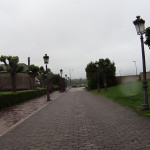
We´ve done this on the 26th of May 2015 and according to my Garmin it took us just under 8 and a 1/2 h to complete the 80 Km that separates Roncesvalles from Puenta la Reina where we decided to stay for the night. Together with me was Fernando, my Pilgrimage partner.
Having done only 30 Km the day before we wanted to push ourselves a little to bring us closer to the average 60 Km per day we planned to do all the way to Santiago. This proved to be unnecessary later, but when you have a scheduled return date you have to account for some spare time in case you run into any problems during the journey. We also had the intention of riding further to Cape Finistere if we got to Santiago with time to spare.
We left Roncesvalles just before 8:00am and didn´t know exactly where we were going to stop. Puenta la Reina was one of the options. For any visually impaired person listening to this account, the day started wet and rainy. According to Garmin as we started the temperature was 12C falling to 5C 1h later and peaking at 19C around 2:30pm. Although it wasn´t necessarily cold it called for something warm to be worn.
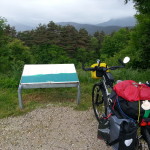
Roncesvalles is still situated mid-ways up in the mountain (Pyrenees). The ride starts with an initial descent of about 200m in total with a few ups and downs in the 1st 17 Km until the town of Erro where you start a 3 Km climb to the “Alto de Erro” which is at 801m at its highest point. We stopped for a few minutes there to take some pictures.

I had eaten only a banana and a cereal bar as I left Roncesvalles. This became more or less the norm for me during the ride with a proper Breakfast stop later along the way 1 or 2h later. After our short stop in the Alto de Erro, we rode for another 7 Km and decided to stop for Breakfast in Zubiri which is a little village 28 Km from Roncesvalles. It had taken us 2.5h to get there and by that point I was really hungry.

Zubiri is lovely small village. It’s the point where we first met the River Arga which flows parallel to the road almost for about 20 Km thereafter, all the way to Pamplona. The village appears to live entirely of the tourism generated by the Pilgrims as there seem to be too many hostels and hotels for such a small place. My breakfast included 2 pieces of a delicious Potato Omelette or “Tortillas de Patatas” as it’s known in Spanish as well as some pastries like a
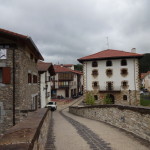
Croissant and a chocolate roll served with coffee and a freshly squeezed orange juice. There are many things I miss from my time in Spain but the sweet and freshly squeezed orange juice is one of the things in the top of the list. This simply does not exist in Britain and even in places where natural orange juice is served the taste is nowhere near that of the sweet and non-acidic Spanish oranges. After Breakfast we walked to the very old looking stone bridge of the village, took some pictures, stamped our pilgrims´ credentials and continued to Pamplona.
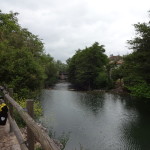
Moving on, we continued on the N-135 road or “Carretera”, as it´s called in Spanish, all the way to the outskirts of Pamplona where we took a cycle path along the river Arga. The Arga also crosses a portion of Pamplona. As we got to the outskirts of Pamplona we stopped for a minute contemplate and take a few pictures of the serene scenes the river Arga was providing.
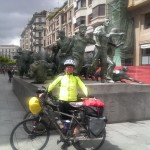
Our passage through Pamplona was very quick. Pamplona is where the famous running of the bulls happen, known in Spanish as the “Encierro“. We only stopped for a few minutes at the bull run monument in the city centre and at the pilgrim´s office to stamp our credentials. At that point in the journey we thought we were pressed for time and we didn´t want to arrive too late in our destination that day. We also knew we were coming back to Pamplona anyway since it was there that we were going to return the rental car we reserved to drive back from Santiago.

We crossed the city and got a bit lost in the park where the Citadel is located, but that allowed us to stop for a minute and take a few pictures. Really impressive example of an old military complex. As we left the city and started to get into more rural areas we met a local cyclist who advised us to avoid the walker´s path up to the “Alto del Perdón” (Mount of Forgiveness), which is one of the
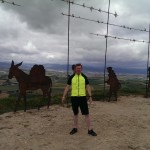
many landmarks along the Camino. The company that runs the wind turbines on that mountain has created a number of bronze sculptures to celebrate the Pilgrims who climb it. The road route is about 4 Km longer than the walker´s path. Even though I perfectly understand Fernando´s reluctance to take the walkers´ path, I confess I was a bit disappointed. I only realised how big the challenge was going to be when I got up there and saw all the bikers pushing their bikes up. We took the NA-6004, then a left turn on the NA-1110, which runs parallel to the A-12 motorway, in the direction of Astrain. The climb is long but perfectly rideable even when you leave the NA-1110 to climb the NA-6056 in the direction to the mountain alongside the wind turbines.

I believe getting to the top of the “Perdón” provides the Pilgrim with the first real feeling of achievement in the Pilgrimage. The altitude recorded by my Garmin was 682m, which is by far not the highest mountain along the way, but perhaps because it’s so well known, or perhaps it’s because of the long challenging climb, I think there is something about that view on both sides that made an impression on me.

On one side you see Pamplona in the background and on the other you have the view of the entire valley where Puenta la Reina is situated. It´s a really magnificent view, but I guess the pictures are worth more than a thousand words. Oh by the way, if you ever wondered why there are so many wind turbines in Spain, the noise you´ll hear in a moment should provide a clue. As the saying goes, everything that goes up must come down, so no surprise that after the Perdón you´re in for a long descent. The NA-6056 which is the minor road alongside the Wind Turbines requires attention because it´s littered with pot holes, but once you are back to the NA-1110, an excellent main road, the pavement is smooth and allows for much higher speeds. In fact, it was on this descent that I achieved the highest speed in the entire journey and probably the highest speed of my life on a bicycle so far: 74.8 Km/h (or 48 mph) according to my Garmin Edge. A great rush of adrenaline.
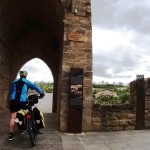
The distance between the Alto del Perdón and Puente la Reina is about 10 Km and it´s mostly descent, so after the Perdón you get to Puente la Reina pretty quickly. What a lovely town Puente la Reina is and its impressive main landmark: The romanic bridge over the river Arga (yes the same that crosses Pamplona). It was built by Queen Mayor (hence the name Puente la Reina or “Bridge of the Queen”) to allow pilgrim´s to easily cross the Arga.

We stayed at the “Albergue de peregrinos de los padres reparadores” (Pilgrims´ Hostel of the Fathers´ repairers?) which cost just €5 a night. The Albergue is very simple and if you are too fussy you will have issues with the shower rooms and the fact that there are almost no power outlets in the bedrooms, so people that want to charge their phones or gadgets fight for the few there are. One pilgrim actually left his phone in the bathroom to charge and stayed there for almost an hour while the phone was charging, something I would never do.
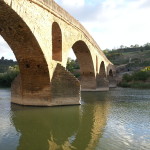
In the next day as we were leaving the Albergue we met Paula for the 1st time. Paula was from Brazil and was doing the pilgrimage by bike, with the main difference that she was on the road much longer than we were, since she started from the Notre Dame cathedral in Paris. Well, that´s it. I will try to produce one post every week. Even though I am benefiting from this writing exercise (especially in German), it hasn´t been easy to find the time to do this in 3 languages. I will complete this Pilgrimage series in all languages, but I may decide concentrate everything only in English in future “adventures”.

